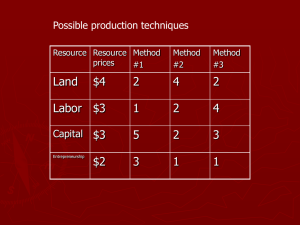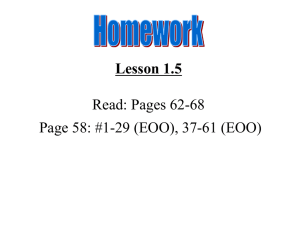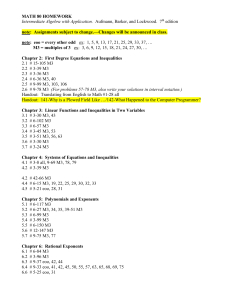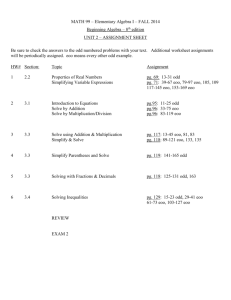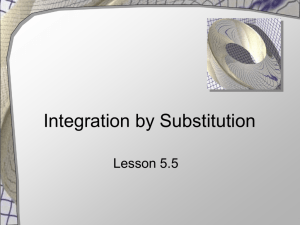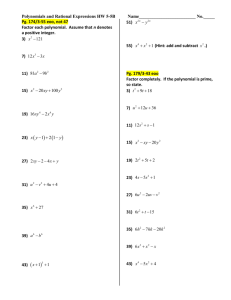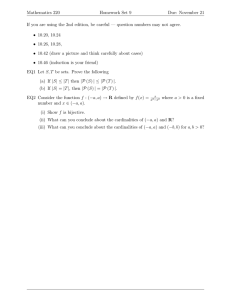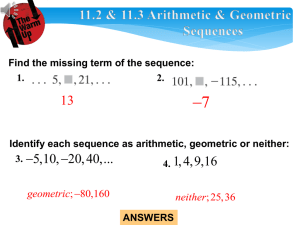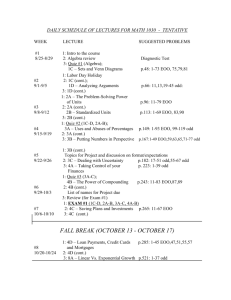499)
advertisement
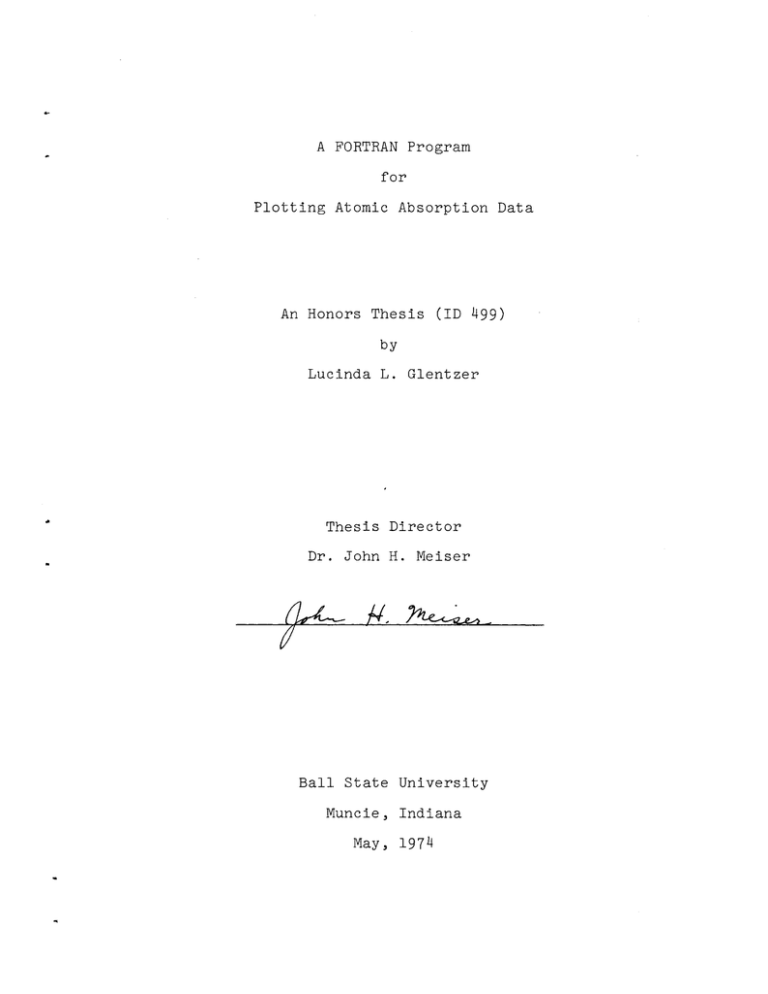
A FORTRAN Program
for
Plotting Atomic Absorption Data
An Honors Thesis (ID 499)
by
Lucinda L. Glentzer
Thesis Director
Dr. John H. Meiser
Ball State University
Muncie, Indiana
May, 1974
;,."c,(oll
T 11( ,;1:.:
-r'
I
/'
j.J
(I .. ;",
. /.-;; ,:
I
~-. .. I'J.J
.J54
ACKNOWLEDGEMENTS
In the course of this research, I had the help of
many individuals.
Special thanks go to Dr. John H. Meiser
of the Chemistry Department who not only sponsored this
project, but has given me moral support from time to time.
Dr. Meiser also provided initial funds for this research
through his Ball State University Faculty Grant.
I wish to express my appreciation to the members of
the staff of the Research Computing office at Ball State
University for helping me to refine the computer program.
I especially wish to thank Dr. Donald M. Smith of that
office for taking his time to help me to understand the
mathematics of the multiple regression process.
I am also grateful to Ball State University for the
use of their computer facilities in the development of
this program.
INTRODUCTION
The computer program contained herein was written to
fulfill the thesis requirement of the Honors Program.
The computer program is designed to convert readings taken
from an atomic absorption spectrophotometer into concentrations over a wide range of variation in readings.
This program was written specifically to transform the
data developed in a current study of diffusion properties
of metal ions made at Ball State University.
However the
program can readily be revised to a more general form.
THE EXPERIMENT
The research project for which the program was written
is designed to measure metal ion concentration in diffusion studies.
Experimentally a petri dish is filled with
a 0.5% agar gel.
Two reservoirs are then made in the
agar with a distance of four centimeters between them.
Solutions of metal ions are then placed into the reservoirs and allowed to diffuse for varying lengths of time.
The ions are chosen so that precipitation of the counterdiffusing ions from the two reservoirs occurs at certain
positions in the gel.
This periodic precipitation appears
as bands in the gel and is known as Liesegang phenomenon.
Analysis of the gel on a distance basis from one
1
reservoir or the other gives an indication of the position
of the precipitated bands as well as the concentration
of the species between the bands.
Consequently, through
analysis, the diffusion curves for both species are found.
Although the present analysis of a diffusion sample involves removing two groups (sets A and B) of ten equally
spaced sections between the two reservoirs, additional
groups may be accommodated by the program.
Currently,
set A is taken close to one reservoir, then set B is removed parallel and offset from set A by one-half the distance between sections.
A typical investigation for an ion requires four
parallel sets of sections from two separate samples to be
analyzed after
24, 48, and 72 hour intervals.
Since one
gel formulation will produce 20 samples, this yields a
total of 240 samples to be analyzed for each ion.
Analytically, a set of standard solutions of the ion are
tested and plotted (concentration versus absorption reading)
to determine a calibration curve for each ion.
Then each
sample absorption reading must be converted to a concentration and plotted on a concentration versus distance
graph.
The standard technique in converting atomic absorption readings involves a linear relationship between the
readings and their respective concentrations.
2
In the
samples used at Ball State University large variations
in concentrations caused difficulty in maintaining the
linear conditions.
Since it is difficult to know the con-
centrations to be expected prior to sectioning the sample,
it is almost impossible to choose starting concentrations
that will yield a linear relationship in the samples to
be analyzed.
Different dilutions could be made on the
same set of data, but this would be impractical.
Con-
sequently, the computer program has been written to provide for a wide range of concentrations so that unnecessary complications arising from dilution are not introduced.
METHOD
This program was written in FORTRAN IV programming
language, and is compatible with the IBM FORTRAN G-level
compiler.
It has been run on Ball State University's
IBM 360-50 computer and requires approximately 84,000
bytes of storage for execution.
The program uses data readings from standard samples
of each ion to determine a calibration curve.
In initial
work, this curve was a straight line and its equation
(a first degree polynomial) could be readily determined
using the method of least-squares.
This method proved to
be highly accurate when the ion concentrations were in a
3
linear range (generally up to five parts per million).
However, certain ions, for instance calcium, when diffused
in higher concentrations (approximately 5 ~g/ml) do not
give calibration curves which are straight lines.
curves may be second or third degree equations.
Their
Although
the least-squares method could still be used, it involves
the use of Cramer's Rule which is extremely time consuming
when programmed for a computer.
It was therefore decided
that a multiple regression with independent variables
x, x 2 , x 3 , and IX could be used to determine the equation
of the molarity, where x is the reading taken from the
atomic absorption spectrophotometer.
The program was
then rewritten using a multiple regression to determine
the equation of the calibration curves.
In order to use a multiple regreSSion, the molarity
was used as the dependent variable, and the reading,
its square root, its square, and its cube were used as
independent variables.
The multiple regression determines
which of the variables are more highly correlated with
the dependent variable.
The degree of correlation of two variables is measured
by a coefficient of correlation.
This program uses the
Pearson product-moment correlation coefficient.
given by the following formula:
r
xy
=
4
It is
where 0xy is the covariance of x and y and ox' 0y are the
standard deviations of x and y, respectively.
This formula
was chosen since the covariance matrix was needed to
determine the coefficients of the dependent variables
chosen to enter the regression equation.
The formula for
the covariance of x and y is
= O:XY -
L:XL:Y/N)/N
The formula for the standard deviation of x is
=
/£ (X ... X) 2/N
In both of these formulas, each X and Yare paired observed values, N is the number of observations, and X
is
the mean of the observed XIS.
Since not all of the independent variables will enter
the equation of the calibration curve, a "lowest acceptable
correlation for entering" must be determined.
This cor-
relation value was determined using the t-statistic, a
variation of the normal distribution (Gaussian or Bell curve).
Therefore a z-score (normal distribution) was set to determine the correlation.
of 1.96.
The program used a constant z-score
In comparing percentiles and z-scores, a z-score
of 1.96 corresponds to 95% in a two-tailed test.
This
means that by choosing a z-score of 1.96, there is a
probability of .95 that a particular independent variable
does not correlate with the dependent variable by chance
alone.
The covariance matrix is then condensed, retaining the
5
dependent variable and those independent variables which
are more highly correlated (these have entered the regression equation).
This matrix is then inverted.
The
diagonal elements of the inverted condensed covariance
matrix are the beta weights of the variables and become
the coefficients of their respective terms in the equation
of the calibration curve.
This multiple regression subroutine was tested against
BMD02R, a stepwise regression in the Biomedical Computer
Program Series. l
The results varied by less than 0.00001.
The data points were plotted on a graph using the
CALCOMP plotter.
This plotter was directed by a magnetic
tape which was generated by the computer during execution
of the program.
was drawn.
On this same graph the calibration curve
By looking at this graph, one could estimate
the accuracy of the calibration curve.
It has proven to
be fairly accurate if five or more data points are supplied.
Fewer data points than this result in a less
desirable fit.
Once the calibration curve was determined it was
used to determine the molarity for each of the samples
of two groups which were labeled groups A and B.
The
IThe documentation for this program can be found in the
BMD Biomedical Computer Programs.
Dixon, W.J., BMD Biomedical Computer Programs, University of California Press, Berkeley, 1971, pp. 233-258.
6
molarity of Group A was then plotted against its distance
from the reservoir on a second graph.
Group B was offset
by .5 and plotted on that same graph.
Then points from
groups A and B were alternated and this combined group
of A's and B's was plotted on a third graph.
I wrote the entire program with the exception of a
small matrix inversion subroutine which was taken from
an article written by Henry F. Kaiser. 2
DOCUMENTATION
This program was written by Lucinda Glentzer at Ball
State University in April 1973.
It converts readings taken
from an atomic absorption spectrophotometer into concentrations, over a wide range of variation in readings.
These
concentrations are then plotted against distance using the
CALCOMP plotter.
2"A Fortran Program for Inverting a Positive Definite
Matrix," Henry F. Kaiser and Kern W. Dickson.
Educational and Psychological Measurement, 32, (1),
1972, pp. 179-180.
--
7
SET-UP
A.
GROUP CARD (I-field)
Col.
Contents
3
Number of data groups for this run
(~5),
B.
TITLE CARD (A-field)
Col.
Contents
1-80
Title of data group, ID
C.
LENGTH CARD (I-field)
Col.
Contents
2-3
Length of title on TITLE CARD, IOD
D.
CONSTANTS CARD (F-fields - decimals must be punched)
Contents
Col.
Molarity of standard samples, CF(l)
1-10
~g/ml. for standard samples, DF(2)
11-20
E.
STANDARD NUMBER CARD (I-field)
Col.
Contents
1-3
Number of standard readings, Nl
F.
STANDARD CARDS (E-fields)
Nl cards each containing
Col.
Contents
1-10
Reading
11-20
~g/ml.
G.
SAMPLE NUMBER CARD (I-field)
Col.
Contents
1-3
Number of Samples, N2
H.
SAMPLE (A) CARDS (E-fields)
N2 cards each containing
Col.
Contents
Reading of a group A sample
1-10
I.
SAMPLE (B) CARDS (E-fields)
N2 cards, each containing
Col.
Contents
1-10
Reading of a group B sample
Repeat B-1, LDO times.
8
LDO
SAMPLE SET-UP
IIRCOOOOOO JOB C3713,1017),116MEISER,MSGLEVEL=1,CLASS=D
II EXEC PLOTMISC,PROGRAM=ATABPLOT,TIME=99
IIGO.STEPLIB DD DSN=RES,USERLIB,DISP=SHR
IISYSIN DD *
1
178BA-B MG
MG STANDARD
23
0.02057
500.0
6
1.EOO
48.EOO
2.EOO
98.EOO
240.EOO
5.EOO
10.EOO
484.EOO
15.EOO
676.EOO
20.EOO
882.EOO
10
525.EOO
398.EOO
367.EOO
275.EOO
267.EOO
193.EOO
176.EOO
105.EOO
97.EOO
60.EOO
457.EOO
439.EOO
338.EOO
305.EOO
244.EOO
227.EOO
151.EOO
123.EOO
83.EOO
65.EOO
1*
II
Any questions concerning this program should be directed
to Dr. John H. Meiser of the Chemistry Department at Ball
State University.
9
PROGRAM
The following pages contain a copy of the computer
program.
It is followed by the computer print-out generated
by the program for a set of sample data.
The final pages
are the graphs drawn by the CALCOMP plotter for this data.
10
___
~_
.......
":.:r .__ •
IIRCINOVI
Joe
C3713,1017I,008GLENTZER,MSGLEVEL-l,CLASS-0
II EXEC FORTPLeT
XXFORT
eXEC PGM-IEVFORT
XXSYSPRINT 00 SVSOUT-A
XXSYSP~NeH DO
SYSOUT-B
XXSYSLIN
00 oSNAME-&LOAOSET,OISP-CMoO,PASSI,UNIT-SVSSO,
XX
SPACE 2 180,1200,lOO),RlSE),oCB-BlKS(ZE-80
IIFORT.SYS(N DC •
IEF236( ALLee. FOR RCINOYl FORT
IEF2311 OEO
~llOCATEo TO SYSPRINT
IEF2371 000
ALLOCATED TO SYSPUNCH
IEF237I 134
~lLOCATEO TO SYSLIN
IEFZ371 oeo
~lLOCATEO TO SYSIN
IEF1421 - STEP WAS EXECUTED - COND CODE 0000
PASSED
IEFZ851
SVS741Zl.T040301.RFOOO.RCINoYl.LOAOSET
VOL SER NOS2 BSU555.
IEFZ8S1
IEF3731 STEP IFOkT
I START 7~122.o506
IEF3741 STEP IFORT
I STOP
74122.0507 CPU
OMIN 34.17SEC MAIN 86K
XXLKED
EXEC PGM=IEWL,PARM=IXREF,lET,LIST),CONO-C4,LT,FORTI
XXSYSlIB
DO OS~AME=SYS1.FURTLIS,OIS~·SHR
XX
DO OSNAM~=SYS1.PlOTlI8,0ISP=SHR
XXSVSLMOo DO DSNAME=&GOSETIMAIN),oISPzINEW,PASSI,UNIT-SVSoA,
XX
SPACE=11024,120,lO,11),oC8=8LKSIlE-I024
XXSYSPRINT DO SYSOUT=A
XXSYSUTI
DO OSNAME=&SVSUT1,UNIT-SYSoA,SPACE-CI024,(20,lOI,RLSE'.
XX
OCB=BLKSIIE=1024
XXSVSllN
DO OSNAME=&LOAOSET,OISP=(OLo,oELETEI
XX
00 ooNAME=SYSIN
IEF2361 ALLoe. FOR RCINoY1 LKEo
IEF237I 231
ALLOCATED TO SYSll8
IEF2371 130
~LLOCATEO TO
IEF237I 134
~LLoeATEO TO SYSLHOo
IEF2371 OEO
lLLOCATeO TO SYSPRINT
IEF237I 135
ALLOCATED TO SYSUT1
IEF2371 134
~lLOCATEO TO SVSLIN
IEF1421 - STEP wAS EXECUTED - CONo CODE 0000
KEPT
IEF2851
SYS1.FORTLIS
IEF2851
VOL SER NOS= 051210.
KEPT
IEF2851
SYS1.PLOTLIS
lEF2851
VOL SER NOS~ INSTRI.
IEF2851
SYS74122.TO~0301.RFOoO.RCINoVl.GOSET
PASSED
IEF285I
VOL 5ER NOS: 8Su555.
DELETED
IEF2851
SYS74122.T040301.RFOOO.RCINoYl.SYSUTl
tEF2B51
VOL SER NOS= BSU66b.
DELETED
IEF28SI
SYS74122.T040301.RFOOO.RCINOY1.LOADSET
IEF28SI
VOL SER NOS= BSU555.
IEF3731 STEP ILKEO
I START 14122.0507
IEF3741 STEP ILKEO
I STOP 74122.0507 CPU
OHIN 07.39SEC MAIN 106K
XXGO
EXEC PG~= •• LKEO.SYSLMOo,COND=((4,lT,FORTI,(4.LT,lKEDII
XXPLOTTAPE 00 UNIT=OUAl,LABEL 2 1,NLI,VOLzSER-PlOTER,DISP-(NEW,KEEPI,
XX
DSNAME=PLCT,DCB=OEN=2
XXFT05FOOI DO DONAME=SY5IN
XXFTObF001 DO SYSQUT=A
XXFT07FOOl 00 SYSCUT=S
IIGO.SYSIN 00 •
II
I~F2361
IEF2371
IEF2371
IEF2371
IEF2Jl1
ALLOC. FOR RCINoYl
134
ALLOCATED TO
380
~LLOCATEO TO
OC1
~LLOCATEO TO
OEO
ALLOCATED To
GO
PGM"·.DO
PLOTTAPE
FT05F001
fTObFOOl
JOB 374
00000010
00000020
00000030
X00000040
00000050
"
LCS
OK
00000060
00000070
00000080
X00000090
00000100
00000110
X00000120
00000130
00000140
00000150
LCS
OK
00000160
X00000170
00000180
00000190
00000200
00000210
• •
,., •• ..,
,.~ ...~
,I
IEFZ371
JEF142J
IEFZ651
lEFZ651
lEF2851
lEF2851
lEF3131
lEF3141
IEF2851
IEf2851
IEF3151
IEf37bl
000
ALLOCATED TO FT07FOOl
- STEP WAS EXECUTED - COND coDe 0000
PAsseD
SVS14122.T040301.RFOOO.RCINDV1.GDSET
VOL SER NOS- B5U555.
PLOT
KEPT
VOL 5ER NOS- PLUTER.
STEP IGO
I START 14122.0507
STEP IGO
I STOP 74122.0509 CPU
OHIN 09.49SEC MAIN
SVS14122.T040301.RFOOO.RCINDV1.GOSET
DELETED
VOL SER NOS- BSU555.
JCB IRCINDY1 I START 14122.0506
JOB IRCINDY1 I STep 74122.0509 CPU
OHIN 51.05SEC
eZK LCS
OK
FORTRAN IV G LEVEL
0002
- 0003
OOO~
"-
v/
0005
0006
0001
0008
0009
0010
0011
0012
0013
0014
0015
0016
0017
00),8
0019
OOlO
0021
0022
002)
0024
0025
0026
0027
0028
0029
0030
0031
0032
0033
0034
0035
0036
0031
0038
0039
0040
OD'd
0042
0043
0044
0045
0046
0041
DATE •
l'~122
05/06/12
PAGE 0001
DIMENSION I8UFFI~0001,XY(6,3ZI,XXC6ZI,YYI3ZI,YNI6ZI,CFC2J,IO(ZOI,
.XSI61,XS2161,XYSI6,61,SXYI6,61,RXYI5,51,SOXI51,IVAI51,8151
CALL PLOTSIIBUFF,~000,61
CALL PLOTeO.0,-1Z.0,-31
REA015,1001 LOO
DO 99 LIMIT s l,LOO
READI5,lD41 10,100
WRI TE Ib, lObI 10
READIS,10JICFIlI,CFI21,CL
REAOIS,1001 N
L:N+ 1
0001
G.;
n r
MAIN
21
J~N+Z
DO Z 1 1 1, N
READI5,101IXYI3,II,XYI6.JJ
XXI 1'=XYIJoI I
XYIZ,I'=SQRTIXY(3,(11
XYI 1, 1l"1.
XYI4,1,=XYIJ,II**Z
XYCS,II=XYI},II**3
XYlb,11=XYlb,I)*CFI11/CFC2J
YYClI=XYI6,1)
XYI6,1'2XYC6,11*10000.
CALL IFCURVIXY,N,XS,XSZ,XYS,SXY,RXY,B,A,JVA,MCLI
CALL SYMBOLIO.0.0.5,.28,lO,90.0,JOOI
CALL PLOTC3.0,-lZ.D,-31
CALL CHNGYCMCL,IVA,B,A,YN,XX,NJ
CALL PLOTIO.0,3.5,-31
CALL SCALEIXX,5.0,N,+11
CALL SCALECYY,5.0,N,+11
CALL AXISIO.0,0.0,'READING',-1,5.0,O.O,XXILI,XXIJII
CALL AXISCO.0,0.0,'MOLES',+5,5.0,90.0,YYILI,YVIJII
CALL LINEIXX,VY,N,1,-l,111
YNCLl =YYCLl
YNIJI"YYIJ)
CALL FLINECXX,YN.N,1,O,OI
READe 5,l001N
L=N+l
J:N+2
WRITE 16, 1071
00 13 JKL-1,2
00 3 l=l,N
REAOl5,101IXYeJKL,tJ
XXIII=XYIJKL,II
CALL CHNGYIMCL,IVA,8,A,YN,XX,NJ
IF(CL.EQ.O.O)GO TO 18
00 19 1=I,N
YNClI=YNIII*CL
WRITEC6,l051
2
15
Z1
3
19
18
I
~. ," "
'-, • ...... i ~
~
-
.. ..
,. ' .. '. ' .....
~-
~~
.. - ......
FORTRAN IV G LEVEL
004S
0049
0050
0051
0052
0053
0054
0055
005b
0051
0058
0059
OObO
OObl
31
13
100
101
10Z
103
104
105
lOb
101
108
00b2
00b3
0064
0065
0066
0061
0068
006'1
0010
9
0011
0012
0073
0014
0015
8
001b
0011
0018
0079
0080
0081
008Z
0083
00114
0085
0066
0087
0068
00d9
0090
0091
0092
0093
0094
0095
..
10
12
21
MAtN
DATE • Hll2
DO 31 I-l.N
XYCJKl+2.II-YN(11
WRITE(6.102IXX(II.YN(II
CONTI~UE
FORMATlI3I
FORMATI2FI0.01
FORMATIIOx.E12.5.2X.E12.51
FORMATI3FIO.11
FORMATIZOA4/I31
FORMATlII
~ORMATI'l',10X,20A4,111
FORMATI12x,'REAOING',7X,'MOLARITV'1
FORMATI'l',11X,'0ISTANCE',7X,'HCLARITY'111
CAll PlUTI8.5,-12.0,-31
CAllPLOTIO.0,1.15.-31
00 'I l"'l,N
YY( I 1=1
CONTI~UE
CALL SCAlEIYN,8.0,N,+11
CAll SCAlEIYY.5.0,N,+11
CAll AXISI0.0,O.0,·OISTANCE',-8,5.0,O.O,VY(LI,YY(JII
CAll AXISI0.0,O.0,'HOlES',S,8.0,90.0,VNCLI,YN(JII
ICK s l
00 12 JK=I,Z
JKl =5-JK
IFIJKl.EQ.41 GO TO 10
00 8 1=I,N
YNIII=XYIJKL.II
00 4 l'"l,N
YYI II=YY(f 1-0.50
CALL FLINEIYV.VN,-N,I,+l,JCKI
ICt< ell
CONTI NUE
CALL FlOTIS.5,O.0,-31
JX"Z·~
00 11 I=2,JX.2
K=I/Z
JK=I-l
Xxll'=K
XXIJKI=XXIII-0.5
VNI I )=XVI4,KI
YNIJK)"XYI3,KI
11 CONTII\UE
l=Z*N+l
J=Z·N+Z
CAll SCAlEIXX,5.0,JX,+11
CALL SCAlEIVN,8.0,JX,+11
CALL AXISI0.O,O.o,'OISTANCE',-8,5.0,0.O,XX(LI,XXIJII
0"06/12
PAGE 0002
FORTRAN IV G lEVEL
0096
0091
0098
0099
0100
0101
010Z
010.3
0104
0105
0106
21
MAIN
DATE· 14122
CALL AXISIO.O,O.O,'MOLES',5,8.0,90.0,YNILJ,YNIJJJ
CALL FLINEIXX,YN,-JX,l.+l,llJ
CALL PLOTI8.0.-12.0.-3J
WRITE (6.108)
L=N·Z
DO 88 l-l,L
88 WRITEI6,102)XXIIJ,YNIIJ
99 CONTINUE
CALL PlOTIO.O,O.O,9S9J
STOP
END
05/06/12
PAGE 0003
FORTRAN IV G lEVEL
21
MAIN
OATE • 'l''H22
.OPTIONS Ih'EFFECT. NOID,EeCDIC,SOURCE,NOlIST,NODECK,lOAD,NOMAP
.OPTIONS IN EFFECT. NAME· MAIN
,lINECNT.
50
SOURCE STATEMENTS.
106,PROGRAM SIZE·
21216
.STATIS1ICS.
.STATlSTlCS. NO OIAGNOSTICS GENERATED
G._
o
"-
{y
05/06/12
PAGE OOM
FORTRAN IV G LEVEL
0001
0002
0003
0004
0005
0006
0007
0008
0009
0010
0011
0012
0013
OOH
0015
0016
0011
0018
001<;
0020
0021
0022
0023
0024
0025
0026
0027
0028
0029
0030
0031
0032
0033
0034
0035
003b
0037
0030
0039
0040
0041
0042
0043
0044
0045
0046
0047
21
IFCURV
DATE. 74122
05/06/12
SUBROUTINE IFCURVIXV,N.XS,XSZ,XVS,SXV,RXV,B,A,IVA,JKl'
DIMENSION XVI6,321,XMI51,
.XSI61,XS2161,XYSI6.61,SXYI6,61,RXVI5,5"SOXI5',JVAI51,B15'
00 97 1-1,6
XSI I '''0.
XS2II'=0.
00 88 J a l,6
XYSII,JI=O.
DO 98 K=l,N
98 XYSII,JI=XYSII,J'+XVII,K,.XVIJ,K,
ee XYSIJ,II=XYSII,JI
DO 97 J=l,N
XSIII"XSIIIHYII,J'
91 XS2II,=XS211,+XYCI,J' •• Z
XN=N
00 99 1-1,5
K-I+l
SOXIII=SQRTICXS2IK,-XSIKI··Z/XN"XN,
00 99 J=I,5
L=J+l
99 SXYII,J'=IXYSIK,L'-XSCL,.XSIK'/XN'/XN
WRITE 16, 100/
100 FORMATIIox,'COVARIANCE MATRIX"
WRITE Ib, 103111SxYI .,JI,J-I,5' ,1-1,51
101 FOR~ATI5X,5F12.3/17X.4FI2.3/29X,3FI2.3/4IX,ZFIZ.3/53X,FIZ.3'
DO 86 1-1.5
DO 86 J=I.5
RXYII,JI=SXYII,JI/ISDXII,·SOXCJ"
e6 RXYIJ,I,=RXYII,JI
WRITE 16.1021
102 FORMATIIII0X,'CORRELATICN MATRIX"
WRI TEl b, 1011 I I RXYI I • J , ,J" I ,5' , I -1,5)
103 FORMATI5X.5EI2.5/11X,4E12.5/29X,3EI2.5/41X,2E12.5/53X,E12.5'
WRITElb.201l
CALL PARTAlIJKL,IVA.RXY,N,SXY,
0092 1=2,JKL
92IVAII,=IVAIIIH
00 93 1"I,JKL
DO <;3 J=I,JKL
RXYII,JI=XYSIIVAIIJ,IVACJ"
93 RXYIJ,II=RXYII,J'
CALL CCNSIRXy,XS,JKLI
00 85 l=l.JKL
85 XS III =0.
DO 84 l"l.JKL
DO 1:4 J=I.JKL
84 XSII'''XSII'.RXYII,JI*XVSIL,IVAIJI'
00 91 l=l,JKL
PAGE 0001
FORTRAN IV G lEVEL
0048
"
0049
0050
0051
0052
0053
0054
0055
0056
0051
0058
0059
0060
0061
0062
0063
21
IFCURV
DATE - 14122
05/06/12
91 8CI )-XSC II
00 96 1-1,5
xMCI
)-1-1
96 XSCI)-O.O
XM(1)a.5
00 81 1'"1,JKl
87 XSIIVAII))zBCII
wRITE 16,2011
wRITEI6,2021 XS(1)
WRITEI6,l031IXMCII,XSCI+1),I-l,4)
wRITE 16,2011
201 FORMAT 11111
202 FORMATIIOX,'THE CONSTANT TERM IS·,E12.5J
203 FORMATIIOX,'THE COEFFICIENT OF THE X•• ',F3.1,' TERM IS·,E12.')
RETUR/I
END
PAGE 0002
FORTRAN IV G lEVEL
21
IFCURV
DATE • 74122
.CPTICNS IN EFFECT. NOID,EBCDIC,SOURCE,NOlIST,NODECK,lOAO,NOHAP
.OPTIONS IN EFFECT. NAME. IFCURV ,lINECNT·
50
SOURCE STATEMENTS.
63,PROGRAH SIlE •
3124
.STATISTICS.
.STATISTICS. NO OIAGNOSTICS GENERATED
05/06/12
PAGE 0003
FORTRAN IV G lEVEL
0001
0002
0003
0004
0005
0006
0007
0008
0009
0010
0011
0012
0013
0014
0015
0016
0017
0018
0019
0020
0021
0022
0023
0024
0025
0026
0027
0028
0029
0030
0031
0032
0033
0034
0035
0036
0037
00J8
0039
0040
0041
0042
0043
21
PAR TAL
DATE - 71t122
SUBROUTINE PARTAlCI.IVA.RXY.N.XVS'
DIMENSION IVACS'.RXYCS.S,.XYSCS.S,
00 1 l-l.S
11VAIIJ-0
KA a l
IVAll,-t
00 210 1-1.4
JK=I+l
00 10 Ma l.5
DO 10 Jal,S
10 XYSIM,J'aRXYIM.J'
l:l
DO 2 K"2,4
2 IFIABSIRXYIK.5".GT.ABSIRXYCl.5'" l-K
l=1.96
DF-N-t
T-Z+IZ··3+l'/14.·CDF-l."
KA"KA+I
X=N-KA
R=T ISQRT( X+T"2'
IFIA8SIRXYCL.5,J.LT.R, RETURN
IF( l. fU.l! XLMa. 5
IFCL.GT.l' XLMzl-l
WRITEI6,200'I.XlM
200 FORMATII0X,'VARIABLE'.12.' ENTERS AN X•• ·.F3.0.' TERM',
IVAIJK'=L
DO 4 K"1.5
IFIK.EQ.l' GO TO 100
DO 3 J=l,5
IFIJ.EQ.LI GO TO 101
RXYIK,J'=XYSIK.J'-XYSCK.l,·XYSCJ.l'
RXYIK,J'=RXYIK,J'/SQRTII1.-XYSlK,l' •• 21.Cl.-XYSCJ.l' •• 21'
GO TO 3
101 RXYIK,J'=O.O
3 CONTI I\UE
GO TO 4
100 00 99 Me 1,5
99 RXYIK,M,eO.O
4 CONTI"UE
210 CONTINUE
1-1+1
RETURN
END
05/06/12
PACE 0001
FORTRAN IV G lEVEL
21
PAR TAL
DATE. 74122
.OPTIONS l~ EFFECT. NOID,EBCDIC,SDURCE,NOlJST,NODECK,lOAO,NOHAP
.CPTIONS IN EFFECT. NAME. PARTAl ,lINECNT.
50
SOURCE STATEMENTS·
43.PROGRAH SIZE·
1628
.STATISTICS.
.STATISTICS. NO DIAGNOSTICS GENERATED
05/06/12
PAGE 0002
FORTRAN IV G LEVEL
0001
0002
0003
0004
0005
0006
0001
0008
0009
0010
0011
0012
0013
0014
0015
0016
0011
0018
0019
0020
0021
0022
0023
0024
21
DONS
DATE. 74122
05/06/12
SUBROUTINE DONSIA.T.NI
DIMENSION AI5.NI.TINI
NLE SS l=N-l
DO 100 Kal.N
IFIAII.II-0.0000011101.101.102
102 X:$QRTIAIl,lIJ
00 1031.1,NlESSl
103 TIII=AII+I,ll/x
TINI:I.01X
00 104 J=l,NLESSl
00 104 l=l,NLESSl
104 AII,JI=AII*l,J*ll-TIII.TIJJ
00 105 l=l,N
105 AII.NI=-TIII*TINI
00 100 J=l,NLESSl
100 AIN.JI=AIJ.NI
00 106 J=l.N
00 106 l=l.N
106 AII.JI=-AII,JJ
GO TO 107
101 WRITE16,10001
1000 FORMhTIIX.'THE MATRIX IS SINGULAR. VERY NEARLY SINGULAR. OR INOEFI
*NITE'I
107 RETURN
END
PAGE 0001
FORTRAN IV G LEVEL
21
OONS
DATE. 74122
.CPTIO~S I~ EFFECTNCIO,EBCOIC,SOURCE,NOLIST,NODECK,LOAD,NOMAP
.CPTIONS IN EFFECT- NAME. DONS
,LINECNT •
50
SGURCE STATEMENTS.
24,PROGRAM SIZE.
1268
-STATISTICS-STATISTICS- NO DIAGNCSTICS GENERATED
05/06/12
PAGE 0002
FORTRAN IV G LEVEL
0001
0002
0003
000'+
0005
0006
0007
0008
0009
0010
0011
0012
0013
001'+
0015
0016
0017
001S
0019
0020
0021
0022
002]
002'+
2
3
'+
5
7
8
9
100
99
21
CHNGY
SUBROUTINE CHNGYINU~,I,B,A,y,X,N'
OIMENSION ICNUMI,BINUMI,YINI,XIN/
A"S(1)
00 1 Lal,N
YIUaO.O
00 8 K=l,N
DO 7 J=Z,NUM
KK=I(J/
CO TO (9,2,],4,5,9/,KK
YIK/=YIK/+SQRTIXCK//.BIJ'
CO TO 7
YIK/=yIK)+XIK)·SIJ/
CO TO 7
YIK/=YIK/+IXIKJ··2/·BIJ/
GO TO 7
YIK/=Y(K)+lxIK) •• 3,.BCJJ
CONTII\UE
YIK/=IVIK/+AI/IOOOO
CONTI",UE
CO TO 99
WRITElb,lOO'
FORMA111X,'WRONC OEPENOENT VARIABLE"
RETURN
END
OATE • 7'+122
05/06/12
PAGE 0001
FORTRAN IV G LEVEL
21
CHNG't
OAfE •
1~122
.OPTIONS IN EFFECT. NOID.EBCOrC.SOURCE.NOLlST.NOOECk.LOAD.NOMAP
.OPTIGNS IN EFFECT. NAME. CHNG't
t LI~ECNT •
50
tSTATIST!CS.
SoURCE STATEMENTS •
2~.PROGRAM SIZE •
1120
*STATISTICS. NO DIAGNOSTICS GENERATED
.STAtIStICs.
NO DIAGNCStlCS tHIs STEP -
05/06/12
PAGE 0002
-
~-
..
- -" --
'
-
-
-~
~-.---"
-
.-------.~.-----.-
F8e-LEVEL LINkAGE EDITOR OPTIONS SPECIFIED XREF.lET.LIST
DEFAULT OPTIONISI USED - SIZE-C10Z400,122881
••• ·MAIN
DOES NOT EX1ST BUT HAS BEEN ADDEO TO DATA SET
"
CROSS REFERENCE TABLE
ENTRY
CONTROL SECTlON
t.AME
ORIG1N
LENGTH
MAtN
IFCURV
PARTAL
DONS
CHNGY
AX1S
FLINE
lHCECOMH.
00
52EO
5F18
6578
6A10
tEOO
1698
52Eo
C34
65C
4F4
460
1Fce
930
1'51
IHCC{)M~2·
8F20
650
•t
<;580
9AE8
564
6FO
SCALE
•
IHCSLOG •
AlOB
HAO
5C2
lHCFRXPI·
A9"8
141
lHCERRM •
HAD
5BC
IHCFCVTH.
e060
1190
••
UHE
PlefS
LOCATION
NAME
LOCATION
NAME
LOCATION
NAME
LOCATJON
lCZ
lab
IHeEFNtl1.
C200
512
1l1CEF10st
CH8
131C
IHCUOPT •
IHCEtRCI1.
OH8
0038
300
zeE
IHCUAtBLt
lHCSSQRTt
eFca
EOOO
lOll
145
SYMBCl
IHCFMAXR.
•
E21a
EBOO
8El
C9
IHCSSCN •
fBOO
le9
F1T4
IHCFRXPR.
•
EOBO
F3EO
62E
1B3
•
F5bll
168
NUMBER
t.AME
FOIOCS-
8084
INTSWTCH
BEFE
9B4C
WHERE
9882
OFFSET
9 BAA
PLOT
98CC
ALOGIO
A1AO
ALOG
A7B8
FRXP1-
A958
ERRMCN
AAAO
lHCERRE
UB8
. AOCONFC Y10UTP
B060
869B
FCYAQUTP
FCYEOUfP
810A
B89A
FCVLOUTP
FCVCOUTP
B19A
8084
FCYlOUTP
tNT6SWCH
B2EA
C09B
ARltH-
C200
AOJSwtcH
C56e
Flees-
C718
FIOCS8EP
C7lE
IHCTRCH
0038
ERRTRA
0040
SORT
EOOO
MAX1
EIlOO
MINl
EB16
AM4X1
EB2C
AMINi
,EB42
cos
EBDO
SIN
EBE8
FRXPR-
F3EO
18COM-
7FC8
SEOOASO
9298
FACTOR
"
- ---
HAME
•
REFlX
IHCSEXP •
LOCATION
"
OC
E4
EC
flo
FC
104
53CC
5304
6004
6644
6FCC
6F04
6FOC
6848
7808
7810
7818
8E04
8E08
8E24
SEI0
BE18
BE20
8DDC
80B4
ecec
91BD
8F68
9300
93FD
9688
9690
A2FC
A904
AA2C
8050
8058
C058
C5CO
C564
C5C4
C87B
0674
DEBO
HAO
ORIGIN
LENGTH
F720
F918
IF8
192
REFERS TO S VM80L
PLOTS
ISCOHa
SYMBOL
SCALE
LINE
SQRT
PARTAL
SORT
SQRT
SeRT
NUMBER
PLOT
SIN
SQRT
REFLX
FIT4
A~AXl
ADCONARITHIHC UOPT
FCVLOUTP
FCVCOUTP
FCV ZOl;TP
IHCCOMH2
IHCCOMH2
IHCCOl'H2
IHCECOMH
IHCERRM
IHCECOMH
IhCECCHH
SYMBOL
A(oIAXl
ALOGIO
I HCERRM
JHCERRM
IBCOM:
FIOCSeEP
IHCERRH
INTSWTCH
IHCUOPT
F IOCSs
IHCERRM
IRCoM:
ADCONa
I BCOI~:
NAME
EXP
IN CONTROL SECTION
PLOTS
IHCECCMH
SYHBOL
SCALE
LINE
IHCSSQRT
PAR TAL
IHCSSORT
IHCSSeRT
IHC SSeRT
NUMBER
PLOTS
IHCSSCN
JHCSSr.;RT
REFLX
F I fit
IHCFMAXR
IHCFCYTH
JHCEFNTH
IHCUUPT
JHCFCVTH
JHCFCYTH
IHCFCVTH
IHCCOMH2
IHCCOMH2
IHCCOMH2
IHCECCMH
IHCERRH
I HC EC OMH
I HC EC OMH
SYHBOL
IHCFMAXR
IHCSLCG
IHCERRM
IHCERRM
IHCECCMH
IHCEF lOS
IHCERRM
IHCECCMH
IHCUOPT
IhC~FIOS
IHCERRM
IHCECoMH
IHCFCVTH
IHCECOMH
LOCATION
NAME
LOCATION
NAME
LOCATION
NAME
F918
LOCATION
EO
E8
FO
F8
100
53C8
5300
6000
6640
6FC8
6FDO
6F08
6B44
7804
780C
7814
11084
8DFC
SE28
8EOC
8E14
8EIC
80BO
80EO
SOB8
eDCO
91CO
8F64
93EO
9684
968C
A2F8
A8Cd
AA28
B04C
B054
C05C
C5BC
C5611
C5CB
C634
D66d
DEAC
DEB4
E lCB
REFERS TO SVM80L
PLOT
IFCURV
CHNGY
AXIS
fL INE
IBCOMDONS
IOCOMa
IBCOMFRXPRSYMBOL
COS
IBCOMa
WHERE
PLOT
SYMBOL
SEQOASO
F IOCSAOJSWTCH
FCYEOUTP
FCVIOUTP
FCVAOUTP
IHCERRE
IHCERRH
IHCCOHH2
IHCCOMH2
IHCECOMH
I BCOM:
IHCECOMH
WHERE
PLOT
FRXPIIBCOMI BCOM:
IHCUOPT
IHORCH
IBCOM ..
IBCOMa
INT6SWCH
AOCON"
IHCERRM
IHCUATBL
I BC014 ..
F 10CSBEP
IHCERRM
IN CONTROL SECTION
PLOTS
IFCURV
CHNGY
AXIS
fLINE
IHCECOMH
DONS
IHCECOMH
IHCECOHH
IHCFRXPR
SYMSOL
IHCSSCN
IHCECOMH
PLOTS
PLOTS
SYMBOL
IHCCOMH2
IHCEFIOS
IHCEFNTH
IHCFCVTH
IHCFCVTH
IHCFCVTH
IHCERRM
IHCERRM
IHCCOMH2
IHCCOMH2
IHCECOMH
IHCECOHH
IHCECOMH
PLOTS
PLOTS
IHCFRXPI
IHCECOHH
IHCECOMH
IHCUOPT
IHCETRCH
IHCECOMH
IHCECOMH
IHCFCYTH
IHCFCVTH
IHCERRM
IHCUATBL
IHCECOHH
IHCEFIOS
IHCERRM
-_._------_. --
LOCATION
_.'------
LOCATION
REFERS TO SYM80L
E568
E564
EDH
EE98
F4FO
f4E8
f 70C
FAtC
ENTRY ADDRESS
TOTAL LENGTH
SIN
PLOT
IHCERRM
PLOT
IBCOMAlOG
SYMBOL
IHCERRH
00
FA80
IN CONTROL SECTION
.
IHCSSCN
PLOTS
(HCERRH
PLOTS
IHCECCMH
IHCSLOG
SYMBOL
IHCERRH
LOCATION
E56C
EOOO
EE94
EE9C
F4F4
F4EC
fA.lO
REFERS TO SYMBOL
COS
IBCOHWHERE
SORT
IHCERRM
EXP
18COH-
IN CONTROL SECTION
IHCSSCN
IHCECOHH
PLOTS
IHCSSQRT
IHCERRH
IHCSEXP
IHCECOHH
175BA-B P8
PB STANDARD
COVARIANCE MATRIX
D.27511E 02 0.56071E 03 0.16955E 06 0.50l81E 08 0.69269E
0.11946E 05 0.38232E 07 0.11835E 10 0.14920E
0.13253E 10 0.43180E 12 0.4B573E
0.14579E 15 0.15215E
0.18702E
CORRELATION MATRIX
1.000
0.978
1.000
0.888
0.802
0.961
1.000
0.8~7
0.982
1.000
VARIABLE 1 ENTERS AN X•• 1. TERM
VARIABLE 2 ENTERS AN X•• 2. TERM
VARIAeLE J ENTERS AN X•• 1. TERM
'1
THE
THE
THE
THE
THE
CONSTANT TERM IS-0.26138E-Ol
C(EFFICIENT OF THE X•• 0.5 TERM IS.16830E-Ol
C(EFFI(IENT OF THE X•• l.O TERM IS.85869E-02
(CEFFICIENT OF THE X•• 2.0 TERM IS.~7230E-05
((EFFICIENT OF THE X•• 3.0 TERM IS.O
REACING
MOLARITY
O.B300E
O.26600E
0.21200E
0.16700E
O.lHOOE
0.ll500E
O.SBOOOE
O.SIOOOE
0.3dOOOE
0.23000E
03
03
03
03
03
03
02
02
02
02
0.42lB6E-03
0.32204E-03
0.24763E-03
0.lS965E-03
0.16l40E-03
0.127C.4E-03
0.29700E
0.24300E
0.iCj700E
O.IHOOE
O.IZtOOE
0.S6000E
0.67COOE
0.38000E
0.28000E
03
03
03
03
03
02
02
02
02
0.36719E-03
0.28970E-03
0.22790E-03
0.16990E-03
0.13991E-03
o .10527E-03
0.73059E-04
0.1tl7SSE-04
O.310S8E-04
0.~6269E-04
0.~572aE-04
0.41795E-04
0.Z5722E-04
01
03
05
08
01
0.966
0.998
0.976
0.921
1.000
.....
..,.
o
I
o
o
...•
o
N
o
...o
o
o
'"...
•
o
I~
-
---"----"-- --
.1"
-:_.
..CLARITY
DIStANCE
0.50000E
0.10000E
0.15000E
0.20000E
0.25COOE
O.30000E
0.J5000E
O.40000E
0.45000E
O.SOOOOE
O.S5COOE
O.60CDOE
0.65COOE
O.10COCE
O.150DOE
O.BOCDOE
O.85000E
0.90000E
0.95COOE
O.LOOOOE
00
01
01
01
01
01
01
01
01
01
01
01
01
01
01
01
01
01
01
02
0 .... Z186E-03
0.36719E-03
O.32204E-03
0.28'>70E-03
0.24l63E-03
0.22790E-03
0.18965E-OJ
0.16990E-OJ
0.16140E-03
0.13991E-03
0.12104E-03
0.10521E-03
0.~62b9E-04
O. BDS':IE-D4
0.55728E-04
O. H 7'i5E-04
0." 11SSE-04
0.31098E-04
0.25122E-04
0.17004E-04
a
l..f)
a
::r
a
,
C"
a
(T)
00
a
I
00.00
I
160.00
I
240.00
RERDING
I
320.00
I
400.00
Cl
::r
Lr)
(TJ
Cl
(TJ
Cl
Lr)
(\J
en
I
o
(fJ
W
-'
o
::£:Lr)
..-.
Lr)
Cl
Cl
Cl
'~--------~----------~---------T----------~--------~
en.OO
2.00
4.00
6.00
OISTRNCE
8.00
10.00
(D
If)
CD
=r
o
o
=r
o
,
en
o
CD
o
o
o
o
'~--------~----------~---------T----------~---------'
CU.OO
2.00
~.OO
6.00
DISTRNCE
8.00
10.00
